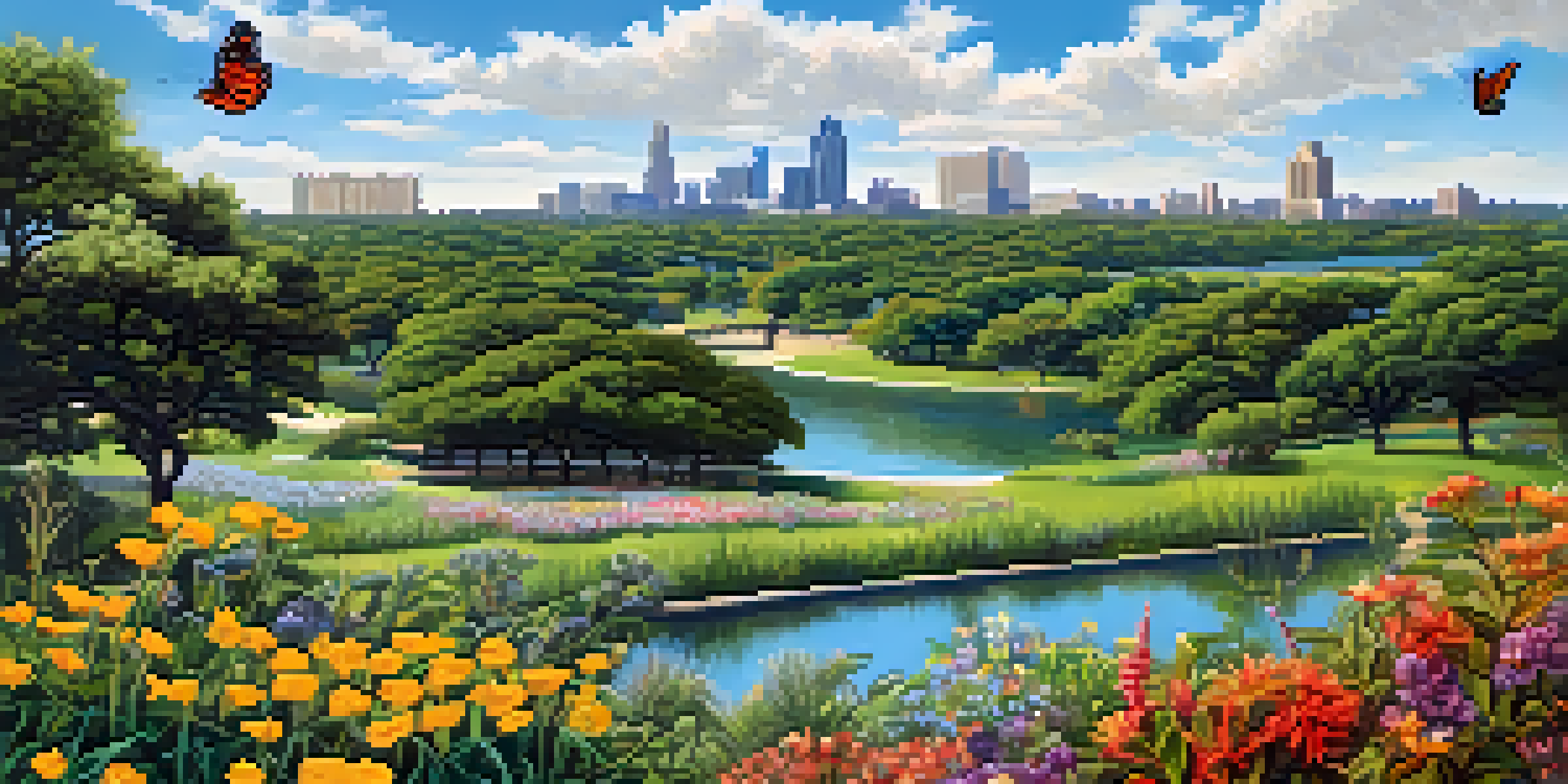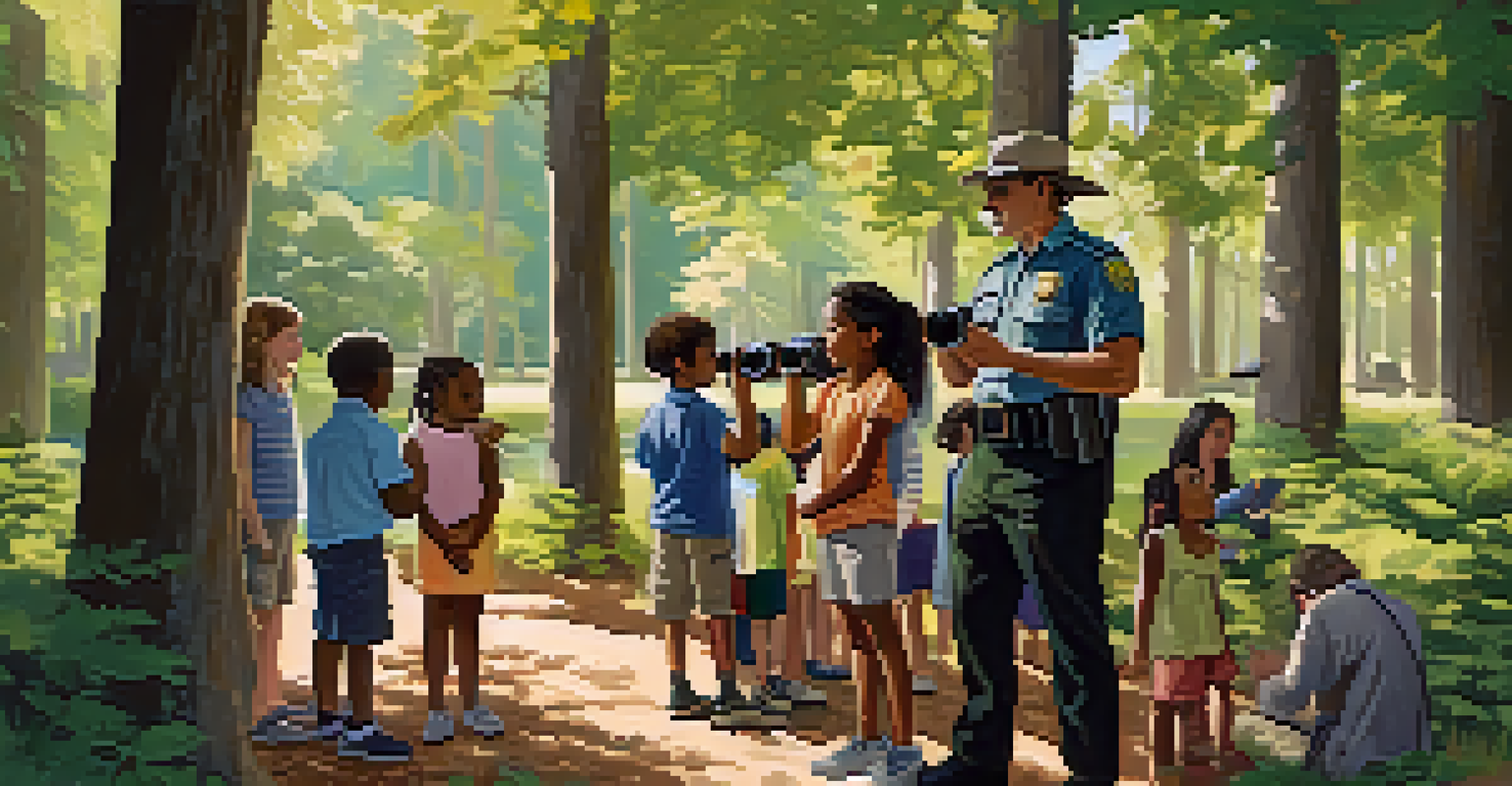The Role of Austin's Parks in Supporting Local Wildlife

Austin's Parks: A Sanctuary for Native Wildlife
Austin's parks play a crucial role in providing habitats for native wildlife. These green spaces serve as vital sanctuaries where various species can thrive, from birds and butterflies to mammals and reptiles. The rich biodiversity found in these parks is essential for maintaining ecological balance in the region.
In every walk with nature one receives far more than he seeks.
The city boasts numerous parks like Zilker Park and McKinney Falls, each offering unique ecosystems. These areas not only house wildlife but also support plant life that is essential for these animals' survival. For instance, native plants provide food and shelter for many species, creating a thriving community.
Moreover, these parks act as corridors, connecting different habitats and allowing wildlife to move freely. This connectivity is crucial, especially in urban settings where development often fragments natural habitats. By preserving these parks, Austin is making a significant investment in its local wildlife.
The Impact of Urbanization on Wildlife in Austin
As Austin continues to grow, urbanization poses challenges for local wildlife. The expansion of roads, buildings, and infrastructure can disrupt habitats and reduce the availability of food and shelter for many species. This disruption often leads to a decline in wildlife populations, making parks even more critical.

However, parks provide a refuge from the encroaching urban landscape. They serve as essential pockets of green that help mitigate the adverse effects of urbanization. By offering a safe haven, these parks allow wildlife to adapt and survive amid ongoing changes in their environment.
Parks as Wildlife Sanctuaries
Austin's parks provide essential habitats that support diverse wildlife and maintain ecological balance.
Community awareness and involvement in park conservation efforts are key to protecting these habitats. Local residents can play a part by participating in clean-up events, reporting wildlife sightings, and advocating for park improvements. Together, these actions create a more supportive environment for wildlife in Austin.
Encouraging Biodiversity Through Park Design
The design of Austin's parks plays a significant role in promoting biodiversity. Thoughtful landscaping that incorporates native plants can attract a variety of wildlife. For example, planting nectar-rich flowers can draw in butterflies and bees, while shrubs provide nesting sites for birds.
The earth has music for those who listen.
Beyond aesthetics, park design can include features like ponds and wetlands that support aquatic wildlife. These water sources are essential for many species, providing habitats for amphibians and a drinking source for terrestrial animals. Additionally, these features contribute to the overall health of the ecosystem by supporting diverse life forms.
Innovative park designs also consider wildlife corridors that facilitate safe movement across the urban landscape. By integrating these elements, Austin’s parks can enhance biodiversity while providing residents with beautiful spaces to enjoy nature.
Educational Programs: Connecting People and Wildlife
Educational programs in Austin's parks help bridge the gap between residents and local wildlife. These programs often include guided nature walks, workshops, and volunteer opportunities that encourage community engagement. By participating, individuals gain a deeper understanding of the ecosystems around them.
Through these experiences, people learn about the importance of preserving wildlife and their habitats. Education fosters a sense of stewardship, motivating community members to take action in protecting local species. For instance, families can participate in birdwatching events, learning to identify local species and appreciate their role in the ecosystem.
Urbanization Threatens Wildlife
The expansion of urban areas disrupts natural habitats, making parks critical refuges for local species.
Additionally, schools often partner with parks for field trips, immersing students in hands-on learning experiences. This exposure can inspire the next generation to value and protect wildlife, ensuring the continued health of Austin's natural spaces.
The Role of Citizen Science in Wildlife Monitoring
Citizen science is playing an increasingly important role in monitoring wildlife in Austin's parks. Local residents can contribute valuable data by observing and recording wildlife sightings. This information helps researchers track population trends and assess the health of various species.
Programs like eBird and iNaturalist allow people to share their findings with the scientific community easily. These platforms not only engage the public but also create a wealth of knowledge that can influence conservation efforts. For example, tracking migratory patterns can guide habitat protection initiatives.
By participating in citizen science, individuals develop a personal connection to their local environment. This involvement empowers communities to become advocates for wildlife, fostering a culture of conservation and responsibility in Austin.
Preserving Water Sources for Wildlife in Parks
Water is a vital resource for wildlife, and preserving water sources in Austin's parks is essential. Parks with ponds, streams, and wetlands provide critical habitats for aquatic creatures and drinking sources for terrestrial animals. Maintaining these water features is key to supporting diverse wildlife populations.
In addition, clean water sources help sustain plant life that is crucial for the ecosystem. Native plants around water bodies create a natural filtration system, improving overall water quality. This not only benefits wildlife but also enhances the recreational experience for park visitors.
Community Engagement is Key
Involvement in conservation efforts empowers residents to protect wildlife and enhance the health of Austin's ecosystems.
Community efforts to protect these water sources can have lasting impacts. Activities like removing invasive species and reducing pollution runoff contribute to healthier ecosystems. By prioritizing water conservation, Austin's parks can continue to thrive as habitats for local wildlife.
The Future of Austin's Parks and Local Wildlife
Looking ahead, the future of Austin's parks and local wildlife depends on continued conservation efforts. As urban development continues, it's vital to prioritize green spaces that support biodiversity. Community involvement and advocacy will be crucial in ensuring these areas are preserved for future generations.
Additionally, ongoing research and monitoring will help identify the needs of local wildlife, guiding park management strategies. By adapting to changing environmental conditions, Austin can enhance the resilience of its parks and the species that inhabit them. This proactive approach will foster a healthier ecosystem in the long run.

Ultimately, the partnership between the city, local organizations, and residents will define the success of these efforts. Together, they can create a vibrant network of parks that not only enrich the lives of Austinites but also support the diverse wildlife that calls this city home.